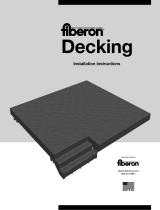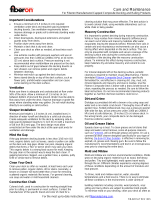
2
Table of Contents
Safety Information ..................................2
Warranty ..........................................2
Pre-Installation .....................................3
Surface Fastening and Fascia Installation ...............5
Cortex Hidden Surface Fastener Installation ..............7
Removing Damaged Cortex Plugs or Screws .............8
Phantom Hidden Fastener Installation - Grooved Edge Decking 9
Hidden Fastener Installation for Paramount Grooved Edge . 12
Post Sleeve Installation .............................14
Safety Information
Read and understand this entire manual before you begin the
installation of your decking.
STATIC ELECTRICITY NOTICE
Dry or windy environments may create a temporary condition of
static electricity, which will vary depending on climate and site
conditions. In the case of excessive static buildup on an installed
deck, Fiberon recommends the following procedure:
1. Remove loose debris from the deck surface.
2. Dilute ACL Staticide
®
Concentrate as directed on the bottle.
3. Spray or mop the entire surface of the deck. Allow to air dry. Do
not attempt to wipe the surface dry as wiping will reduce the
effectiveness of the anti-static coating.
CAUTION: Although very safe in diluted form, ACL
Staticide
®
Concentrate is considered a hazardous chemical
non-diluted. DO NOT use ACL Staticide
®
Concentrate non-
diluted.
WARNING: Use extreme caution when using power tools.
WARNING: This decking is for deck surfaces only, and not
structural applications.
CAUTION: When using a ladder on composite decking, it
is mandatory to lay down a sheet of plywood over the deck
surface to disperse the load of the ladder’s feet to nearby
underlying joists. Drill fasteners downward through the
top of the plywood sheet to keep it from slipping. Position
fasteners so they adequately protrude and rest rmly in
the gaps between the deck boards and into the joists. This
will avoid leaving holes in your decking once the plywood
sheet is removed. Always follow the ladder manufacturer’s
instructions and safety tips.
CAUTION: Unusual sources of heat and heat buildup can
potentially damage decking surfaces. Examples include re
pits, reected light from nearby windows and doors, and
under-deck waterproong installations that do not provide
adequate ventilation. Exercise caution if walking barefoot
on the deck while it is in full sun.
CAUTION: Fasteners have sharp edges. Use proper care
when handling.
Warranty
For more information, visit berondecking.com.
Decking Warranties Paramount
®
Symmetry
®
Horizon
®
Sanctuary
®
ProTect
Advantage
®
Good Life ArmorGuard
®
Veranda
®
by Fiberon
Limited Performance Warranty
Lifetime 25-Year 25-Year 25-Year 25-Year 25-Year 20-Year 15-Year
Limited Stain & Fade Warranty
N/A 25-Year 25-Year 25-Year 25-Year 25-Year 20-Year N/A
Limited Commercial Warranty
10-Year 10-Year 10-Year 10-Year 10-Year 10-Year 10-Year 10-Year
NOTE: Fiberon recommends the use of a quality joist ashing to ensure optimal installation and reduce potential noise caused by the boards
moving against the joist. Products such as Grace Vycor Deck Protector, Tite Seal, or other comparable self-adhesive ashing products enable a
smooth and consistent contact surface between joists and Fiberon decking. All Fiberon decking offers long-term warranty coverage, as noted
above. To extend the life of the joists beneath the decking, we recommend using joist tape. Properly applied, joist tape has proven effective in
protecting joists against premature decay.



























